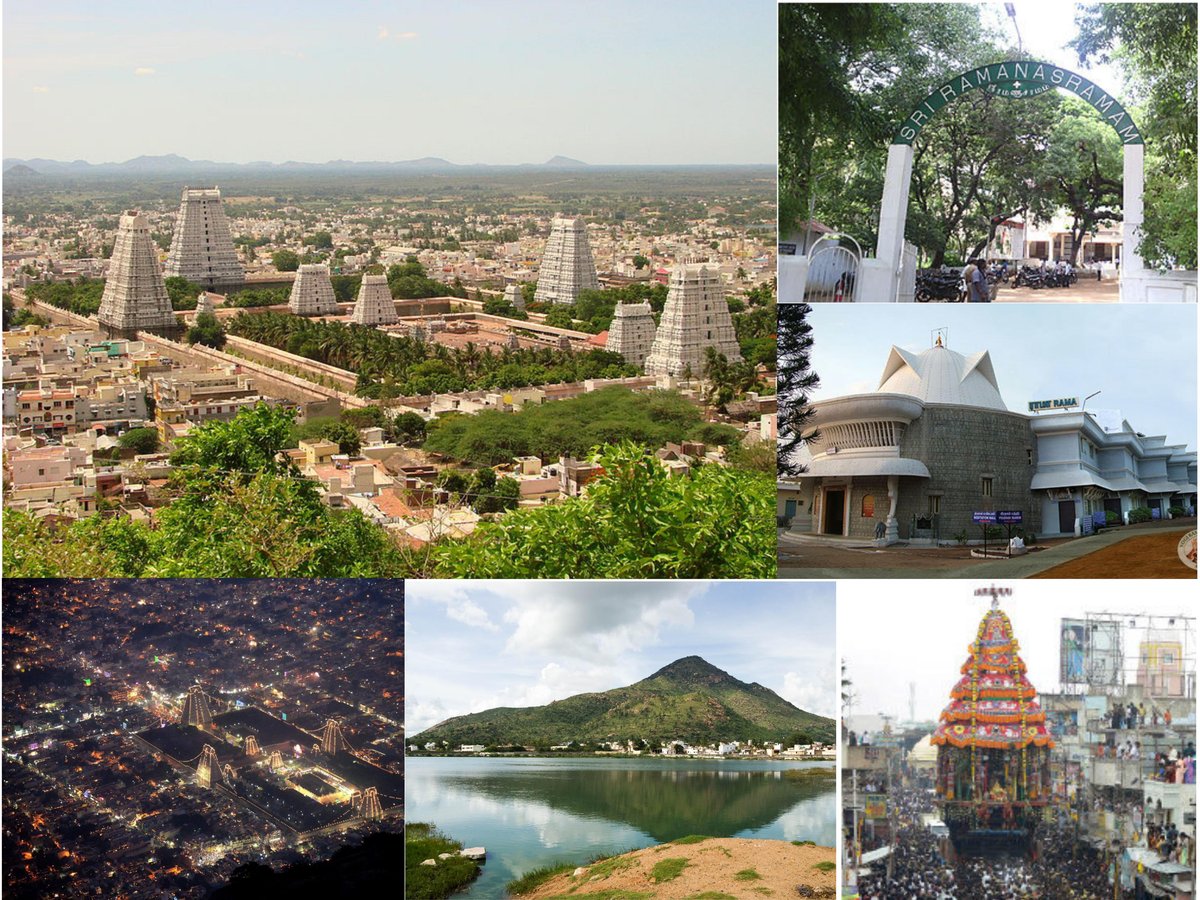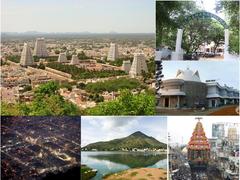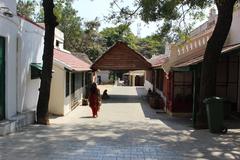
Sri Ramana Ashram Tiruvannamalai: Visiting Hours, Tickets, and Travel Guide
Date: 15/06/2025
Introduction to Sri Ramana Ashram Tiruvannamalai and Its Significance
Located at the base of the sacred Arunachala Hill in Tiruvannamalai, Tamil Nadu, Sri Ramana Ashram is a global center for seekers of spiritual wisdom and inner peace. Established in the early 20th century by the renowned sage Bhagavan Sri Ramana Maharshi, the ashram has evolved from humble beginnings in caves to an internationally respected sanctuary for self-inquiry and meditation (gururamana.org).
Ramana Maharshi’s spiritual journey began at the age of sixteen, when a life-changing realization led him to Arunachala—regarded in Hinduism as the embodiment of Lord Shiva’s formless essence. The ashram’s setting at the foot of this sacred mountain brings profound spiritual significance, attracting visitors from around the world.
Today, the ashram encompasses meditation halls, samadhi shrines, temples, a library, tranquil gardens, and spaces for study and devotion. It is dedicated to the practice of atma-vichara (Self-Inquiry), centered on the question “Who am I?” and is open to all, free of charge. The ashram also provides a schedule of spiritual activities such as group chanting, pujas, and retreats, particularly during auspicious events (gururamana.org, Wikipedia).
The surrounding region offers additional spiritual and cultural experiences, including the historic Arunachaleswarar Temple, the revered Virupaksha Cave, Skandasramam, vibrant markets, and more (tsrvivithagrand.com).
This comprehensive guide will help you plan a meaningful and respectful visit, including details on visiting hours, spiritual practices, accommodations, etiquette, travel tips, and local attractions (sriramanamaharshi.org, arunachala.blog).
Table of Contents
- Origins and Early Development
- Growth and Influence
- The Legacy of Ramana Maharshi
- Spiritual Significance of Arunachala and the Ashram
- Visiting Sri Ramana Ashram: Hours, Tickets & Accessibility
- Guided Tours, Special Events & Photographic Spots
- Nearby Attractions & Tiruvannamalai Historical Sites
- Visuals & Media
- Daily Schedule of Activities
- Ashram Layout and Key Facilities
- Activities for Visitors
- Visitor Guidelines
- Accommodation Options
- Safety, Security, and Practical Advice
- Dining and Accommodation
- Environmental and Cultural Sensitivity
- Nearby Attractions and Best Time to Visit
- References and Further Reading
Origins and Early Development
Sri Ramana Ashram (Sri Ramanasramam) owes its inception to the spiritual awakening of Ramana Maharshi in 1896. At sixteen, Ramana Maharshi experienced a profound realization about the nature of the Self, prompting him to leave his family home in Madurai and settle at Arunachala (gururamana.org). Initially, he lived in solitude in caves and small shrines. The ashram began to form in 1922 with the samadhi of Ramana’s mother, Alagammal, at its core. By 1924, the ashram consisted of two huts: one for Ramana Maharshi and another for visitors (Wikipedia).
Growth and Influence
As news of Ramana Maharshi’s presence spread, the ashram became a magnet for spiritual aspirants from India and abroad. Notable early visitors included Paul Brunton, whose writings introduced Ramana’s teachings to the West, as well as figures like W. Somerset Maugham, Swami Sivananda, and Paramahansa Yogananda (Wikipedia). Over time, the ashram expanded to include meditation halls, a dining area, a library, and accommodations. The journal The Mountain Path, edited by Arthur Osborne, became a respected source of spiritual literature.
The Legacy of Ramana Maharshi
Ramana Maharshi remained at the ashram until his passing in 1950. His death was marked by accounts of a luminous star moving toward Arunachala, symbolizing his liberation (gururamana.org). Since then, the ashram has continued under the administration of his family, maintaining its reputation as a vibrant spiritual center (Wikipedia).
Spiritual Significance of Arunachala and the Ashram
Arunachala Hill is revered as the “spiritual heart of the world” and the formless aspect of Shiva. Ramana Maharshi regarded the mountain as his guru and encouraged devotees to practice giri pradakshina—the circumambulation of Arunachala (ramana-maharshi.org). The ashram’s core teaching, atma-vichara, places emphasis on direct self-inquiry over ritual, fostering an atmosphere of contemplation and inner silence (gururamana.org).
Visiting Sri Ramana Ashram: Hours, Tickets & Accessibility
Visiting Hours:
- Open daily from 6:00 AM to 8:30 PM, with early morning and evening recommended for meditation.
Entry Fee:
- The ashram is open to all; no entry fee or ticket is required.
Accessibility:
- Wheelchair access is available on paved paths; assistance can be arranged for those with mobility needs.
Travel Tips:
- Tiruvannamalai is accessible by train and bus, and the nearest airport is Chennai International Airport (about 180–190 km away). Visitors should dress modestly and keep silence within ashram grounds.
Guided Tours, Special Events & Photographic Spots
- Guided Tours: No formal tours, but volunteers may provide orientation. Self-guided exploration is encouraged.
- Special Events: Spiritual festivals and retreats are held during full moon days and anniversaries such as Vibhuti Day. Check the ashram’s website for schedules.
- Photography: Allowed only in outdoor spaces; restricted inside meditation halls and shrines.
Nearby Attractions & Tiruvannamalai Historical Sites
Significant attractions include the Arunachaleswarar (Annamalaiyar) Temple, the Girivalam path, Virupaksha Cave, Skandasramam, Siva Ganga Tank, Sathanur Dam, Gingee Fort, and other ashrams like the Sri Seshadri Swamigal Ashram (tsrvivithagrand.com, adotrip.com, travel.india.com).
Visuals & Media
High-quality images and virtual tours are available on the ashram’s official website (sriramanamaharshi.org). Including photographs with descriptive alt tags like “Sri Ramana Ashram visiting hours” and “Arunachala Hill spiritual site” enhances accessibility and understanding.
Ashram Layout and Key Facilities
The ashram’s design supports meditation, study, and community living. Key facilities include:
- Samadhi Hall: Central shrine for Sri Ramana Maharshi’s samadhi.
Hours: 5:00 AM–12:30 PM, 2:00 PM–9:00 PM. - Old Hall: Where Sri Ramana spent much of his time.
Hours: 4:00 AM–12:30 PM, 2:00 PM–9:00 PM. - New Hall: For larger gatherings, with a life-sized statue.
Hours: 5:00 AM–12:30 PM, 2:00 PM–9:00 PM. - Matrubhuteswara Temple: Shrine to Sri Ramana’s mother; special pujas on Fridays, full moon days, and the first day of each Tamil month.
- Dining Hall: Serves vegetarian meals at set times.
- Library: Spiritual literature in various languages.
Hours: 8:30 AM–11:00 AM, 2:00 PM–5:00 PM. - Bookstore: Sells books and souvenirs.
Hours: 8:00 AM–11:00 AM, 2:00 PM–6:00 PM. - Guest Rooms: Modest accommodation inside and near the ashram; book in advance.
- Dispensary: Free medical care on select days (Tuesdays, Thursdays, and Saturdays from 4:00 PM to 5:00 PM).
Sacred Sites on Arunachala Hill
- Skandasramam: Hermitage where Ramana lived (1916–1922).
Hours: 8:00 AM–5:00 PM. - Virupaksha Cave: Ramana’s residence (1899–1916).
Hours: 8:00 AM–4:00 PM.
Daily Schedule of Activities
Morning
- 5:00–6:45 AM: Meditation in halls
- 6:45 AM: Milk offering at samadhi
- 7:00 AM: Breakfast
- 8:00–8:45 AM: Vedic chanting
- 8:30–10:00 AM: Pujas
- 10:45 AM: Narayan Seva (feeding the poor)
- 11:30 AM: Lunch
Afternoon/Evening
- 2:00–5:00 PM: Library and bookstore open
- 4:00 PM: Tea/milk served; group readings begin
- 5:00–6:00 PM: Vedic chanting
- 6:00–6:30 PM: Evening puja
- 6:30 PM: Tamil recitation
- 7:30 PM: Dinner
- 9:00 PM: Samadhi Hall closes
Special Rituals: Shri Chakra Pooja at the Matrubhuteswara Temple every Friday, full moon day, and first day of each Tamil month.
Activities for Visitors
- Meditation & Self-Inquiry: Practice “I Am” meditation, focusing on inner awareness.
- Satsang & Chanting: Join group readings and Vedic chanting.
- Ritual Worship: Attend daily pujas.
- Pilgrimage: Visit Skandasramam and Virupaksha Cave; undertake Girivalam (14 km circumambulation of Arunachala).
- Volunteering: Assist in kitchen, cleaning, or Narayan Seva.
- Health Services: Free medical aid on selected days.
Visitor Guidelines
- Maintain silence in halls and during meals.
- Dress modestly; remove shoes before entering shrines and halls.
- Do not use mobile phones in sacred spaces.
- Make monetary offerings only at the ashram office.
- Avoid trekking alone on Arunachala Hill, especially for women; use official guides.
Accommodation Options
The ashram offers basic guest rooms for spiritual seekers; additional guesthouses are available nearby. Advance booking is recommended, especially during festivals.
Dining and Accommodation
Simple vegetarian meals are served in a communal dining hall where silence is observed. Guest accommodations are basic, clean, and prioritized for spiritual seekers with advance booking.
Safety, Security, and Practical Advice
- Be mindful of belongings during peak times.
- Politely decline unsolicited services from touts; donate only at official counters.
- Carry small cash for minor expenses; credit cards are rarely accepted.
Environmental and Cultural Sensitivity
- Do not litter; minimize plastic use.
- Smoking, alcohol, and non-vegetarian food are prohibited.
- Avoid public displays of affection; greet elders with “Namaste.”
- Follow local customs and etiquette.
Accessibility and Special Considerations
- Most public areas are open to all; some inner sanctums may restrict non-Hindus during ceremonies.
- Wheelchair access is available in most areas; contact the ashram office for assistance.
Best Time to Visit Tiruvannamalai
- Winter (Nov–Feb): Pleasant weather, ideal for festivals and Girivalam.
- Monsoon (Jul–Sep): Lush, scenic, but some paths may be slippery.
- Summer (Mar–Jun): Hot and dry, less crowded (dagadevelopers.com).
Festival Calendar and Special Events
- Karthigai Deepam (Nov/Dec): Beacon atop Arunachala draws huge crowds.
- Full Moon Girivalam: Monthly circumambulation of Arunachala.
- Arudra Darshan (Dec/Jan): Celebrates Shiva’s cosmic dance.
Practical Travel Tips
- Book accommodation in advance for festival seasons.
- Avoid peak crowds by visiting on weekdays or early mornings.
- Wear light, modest clothing; carry drinking water.
Frequently Asked Questions (FAQs)
Q: What are the visiting hours of Sri Ramana Ashram?
A: 6:00 AM to 8:30 PM daily.
Q: Is there an entry fee or ticket?
A: No; entry is free, donations are welcome.
Q: Are guided tours available?
A: Volunteers may offer informal orientation; self-guided visits are encouraged.
Q: How do I reach the ashram?
A: Tiruvannamalai is accessible by train, bus, and road. The nearest airport is Chennai International Airport (~180–190 km).
Q: Are accommodations available?
A: Yes, for spiritual seekers with advance booking.
Q: Is the ashram wheelchair accessible?
A: Most of the grounds are accessible; assistance is available.
Visual Resources
- Official Sri Ramana Ashram Website
- Map of Sri Ramana Ashram, Tiruvannamalai
- Virtual tours and photo galleries are available on official websites and YouTube.
Conclusion
Sri Ramana Ashram Tiruvannamalai is a sanctuary for those seeking spiritual clarity, inner peace, and cultural enrichment. With its serene atmosphere, rich heritage, and welcoming community, the ashram offers a transformative experience. Use this guide to plan your visit, honor the ashram’s traditions, and immerse yourself in the teachings of Sri Ramana Maharshi.
For more travel guides, updates, and spiritual resources, download the Audiala app and follow our social media channels.
References and Further Reading
- Sri Ramana Ashram Visiting Guide: History, Spiritual Significance, Visiting Hours & Tips (gururamana.org)
- Sri Ramana Ashram (Wikipedia)
- Sri Ramana Ashram Tiruvannamalai: Visiting Hours, Schedule, and Spiritual Activities (sriramanamaharshi.org)
- Visitor Information, Etiquette, and Practical Tips (arunachala.blog)
- Nearby Attractions and Best Time to Visit (tsrvivithagrand.com)
- Girivalam and Pilgrimage Details (touristsecrets.com)
- Places to Visit in Tiruvannamalai (adotrip.com)
- A Modern Pilgrim’s Guide (dagadevelopers.com)
- Additional Local Attractions (balajidarshanbooking.com, majesticresidency.com)

